Design and Experimental Analyses of Hybrid Piston Rods Used in Hydraulic Cylinders under Axial Load
Abstract
:1. Introduction
2. Materials and Methods
2.1. Analysis Method
2.2. Experimental Method
2.3. Test Samples
2.4. Numerical Analysis and Results
3. Results and Discussion
3.1. Experimental Results
3.2. Solid Rod
3.2.1. Buckling Load against Laminates in Solid Hybrid Rod
3.2.2. Buckling Load versus 0° Ply in a Solid Hybrid Bar
3.2.3. Buckling Load against 45° Laminates in a Solid Hybrid Rod
3.2.4. Buckling Load against 90° Ply Laminates in Solid CFRP
3.3. Hollow Rod
3.3.1. Buckling Load VS. Laminates in a Hollow Hybrid Rod
3.3.2. Buckling Load against 0° Laminates in a Hollow Hybrid Rod
3.3.3. Buckling Load versus 45° Laminates in a Hollow Hybrid Rod
3.3.4. Buckling Load against 90° Ply Laminates in Hollow Hybrid Rod
4. Summary and Conclusions
- The buckling load is significantly affected by the percentage of CFRP volume in the hybrid bar, regardless of whether it is a solid or hollow bar. The higher the CFRP volume, the better the buckling load carrying capacity of the hybrid rods.
- The influence of the number of laminate layers on the buckling load depends largely on the angle and orientation of the laminates. They show better strength when the number of laminates is between 30 and 50.
- For axial load, 0° laminate layers bear the largest load compared to other laminate layers, so their number should be larger compared to other laminate layers. However, their volume should not exceed 50% of the total laminate layers. If their volume is more than 50%, the load carrying capacity of the hybrid bar will decrease. The best range is between 25% and 35% for higher buckling loads.
- The buckling load carrying capacity of the hybrid rod increases as the volume of the 45° laminate increases, and a range of 10% to 20% is recommended for best results. This range could be due to the fact that 45° laminate layers resist the bending induced by 0° laminate layers during axial loading, which further increases the buckling load capacity of the hybrid rod.
- The influence of 90° laminate plies on the buckling load capacity of the hybrid rod is much smaller and almost negligible.
Author Contributions
Funding
Institutional Review Board Statement
Informed Consent Statement
Data Availability Statement
Acknowledgments
Conflicts of Interest
References
- Njuguna, J. Lightweight Composite Structures in Transport Design, Manufacturing, Analysis and Performance; Woodhead Publishing Series in Composites Science and Engineering; Woodhead Publishing: Cambridge, MA, USA, 2016; Volume 67, p. 474. [Google Scholar]
- Omar, F.; Jim, T.; Mohini, S. Lightweight and Sustainable Materials for Automotive Applications; CRC Press: Boca Raton, FL, USA, 2017. [Google Scholar]
- Davies, J. Lightweight Sandwich Construction; CIB Working Commision: Manchester, UK, 2001; p. 369. [Google Scholar]
- Mallick, P. Materials, Design and Manufacturing for Lightweight Vehicles; CRC Press: Boca Raton, FL, USA, 2010. [Google Scholar]
- Brigante, D. New Composite Materials; Springer: Berlin/Heidelberg, Germany, 2014. [Google Scholar]
- Solazzi, L. Applied research for weight reduction of an industrial trailer. FME Trans. 2012, 40, 57–62. [Google Scholar]
- Solazzi, L. Wheel rims for industrial vehicles: Comparative and experimental analyses. Int. J. Heavy Veh. Syst. 2011, 18, 214–225. [Google Scholar] [CrossRef]
- Collotta, M.; Solazzi, L. New design concept of a tank made of plastic material for freighting vehicle. Int. J. Automot. Mech. Eng. 2017, 14, 4603–4615. [Google Scholar] [CrossRef]
- Solazzi, L.; Assi, A.; Ceresoli, F. New Design Concept for an Excavator Arms by Using Composite Material Applied Composite Materials. Appl. Compos. Mater. 2018, 25, 601–617. [Google Scholar] [CrossRef]
- Solazzi, L. Feasibility study of hydraulic cylinder subject to high pressure made of aluminum alloy and composite material. Compos. Struct. 2019, 209, 739–746. [Google Scholar] [CrossRef]
- Dump Cylinder-HY18-0032-Parker Hannifin. Available online: https://www.parker.com (accessed on 19 December 2018).
- Uzny, S.; Sokot, K.; Kutrowski, L. Stability of a hydraulic telescopic cylinder subjected to Euler’s load. In Proceedings of the 13th International Scientific Conference; Lecture Notes in Mechianical Engineering Series. Springer: Berlin/Heidelberg, Germany, 2017; Volume F10, pp. 581–588. [Google Scholar]
- Morelli, P. On the buckling behaviour of telescopic hydrasulic cylinders. Key Eng. Mater. 2010, 417–418, 281–284. [Google Scholar]
- Micheal, F. Ashby: Materials Selection in Mechanical Design, 3rd ed.; Butterworth-Heinemann: Oxford, UK, 2003. [Google Scholar]
- Agarwal, B.D.; Broutman, L.; Chandrashekhara, K. Analysis and Performace of Fiber Composites, 3rd ed.; Wiley: Hoboken, NJ, USA, 2006. [Google Scholar]
- Tiwari, A.; Alenezi, M.R.; Jun, S.C. Advanced Composite Materials; Scrivener Publishing LLC: Beverly, CA, USA, 2016. [Google Scholar]
- Balasuramanian, M. Composite Materials and Processing; CRC Press: Boca Raton, FL, USA, 2014. [Google Scholar]
- Kar, K. Composite Materials Processing, Applications, Characterizations; Springer: Berlin/Heidelberg, Germany, 2017. [Google Scholar]
- Schijve, J. Fatigue on Structures and Materials; Springer: Berlin/Heidelberg, Germany, 2009. [Google Scholar]
- Harris, B. Fatigue in Composites Science and Technology of the Fatigue Response of Fibre-Reinforced Plastics; Woodhead Publishing Limited; CRC Press: Boca Raton, FL, USA, 2003. [Google Scholar]
- Vassilopoulos, A. Fatigue Life Prediction of Composites and Composite Structures; Woodhead Publishing Limited; CRC Press: Boca Raton, FL, USA, 2010. [Google Scholar]
- Jones, R.M. Buckling of Bars, Plates and Shells; Bull Ridge Publishing: Blacksburg, VA, USA, 2006. [Google Scholar]
- Lin, R.; Guo, Y.; Lin, H. Critical load and optimum design for hydraulic cylinders. Zhongguo Jixie Gongcheng/China Mech. Eng. 2011, 22, 389–393. [Google Scholar]
- Vullo, V. Circular Cylinders and Pressure Vessel, Stress Analysis and Design; Springer: Berlin/Heidelberg, Germany, 2014. [Google Scholar]

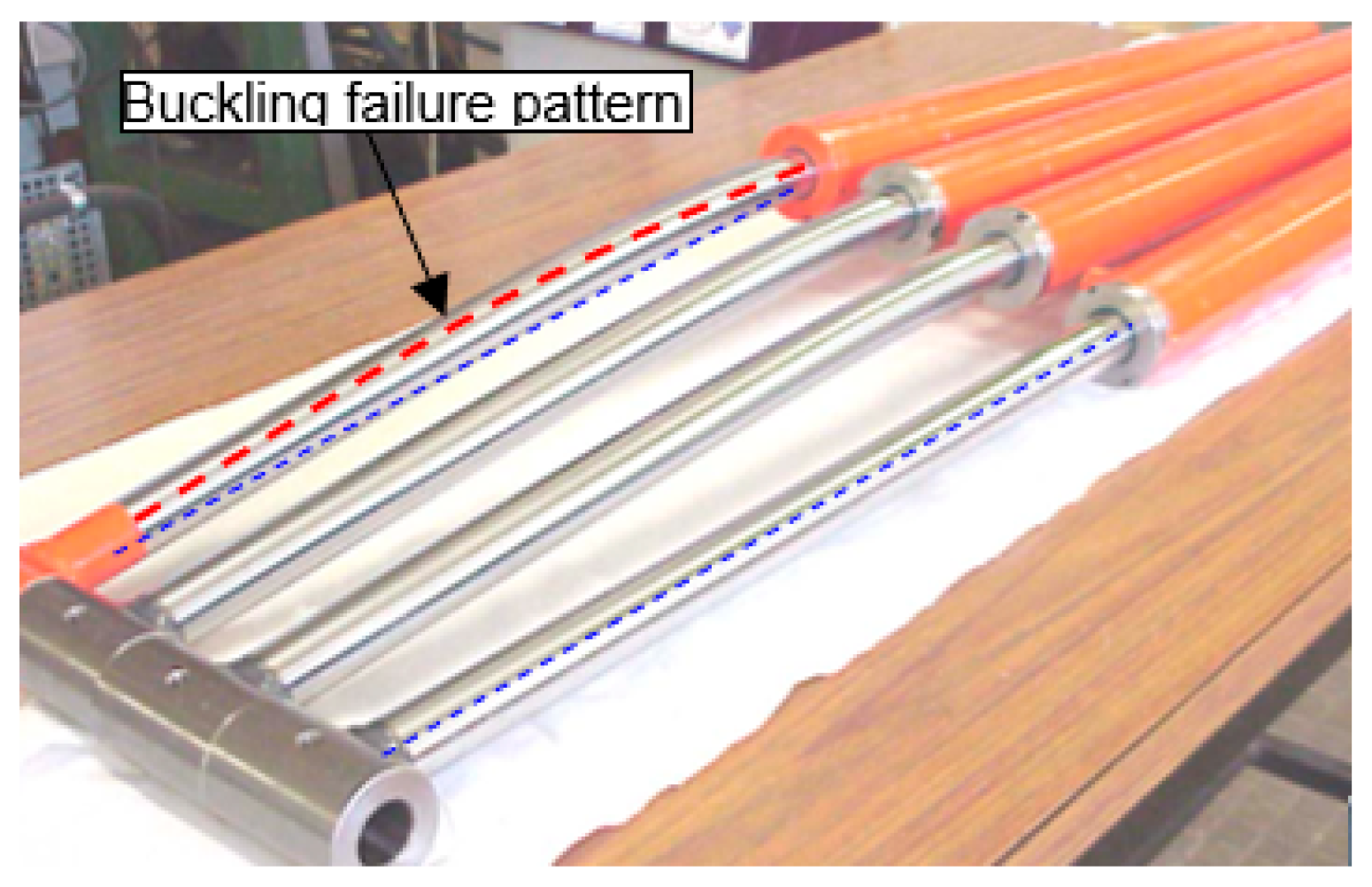
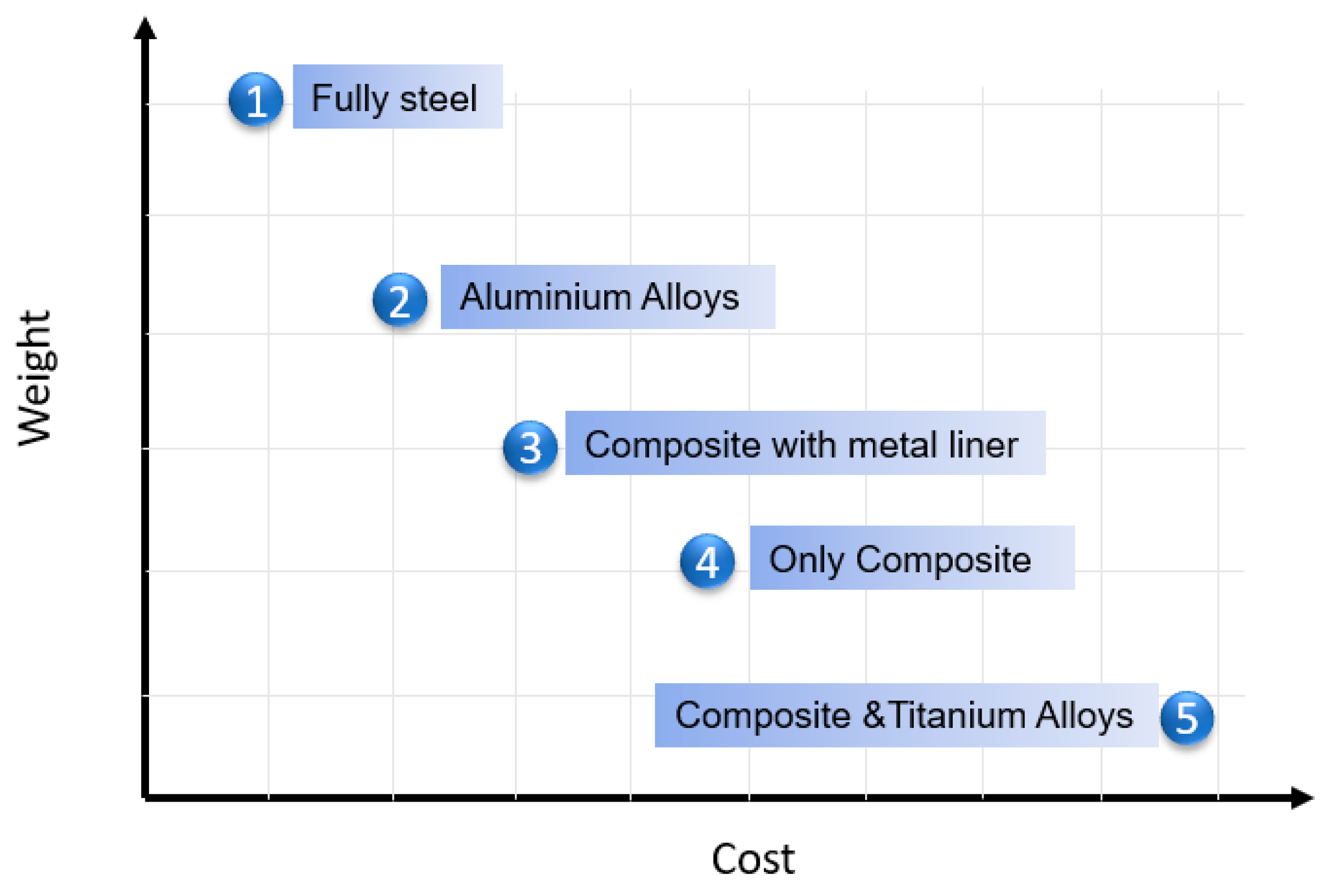
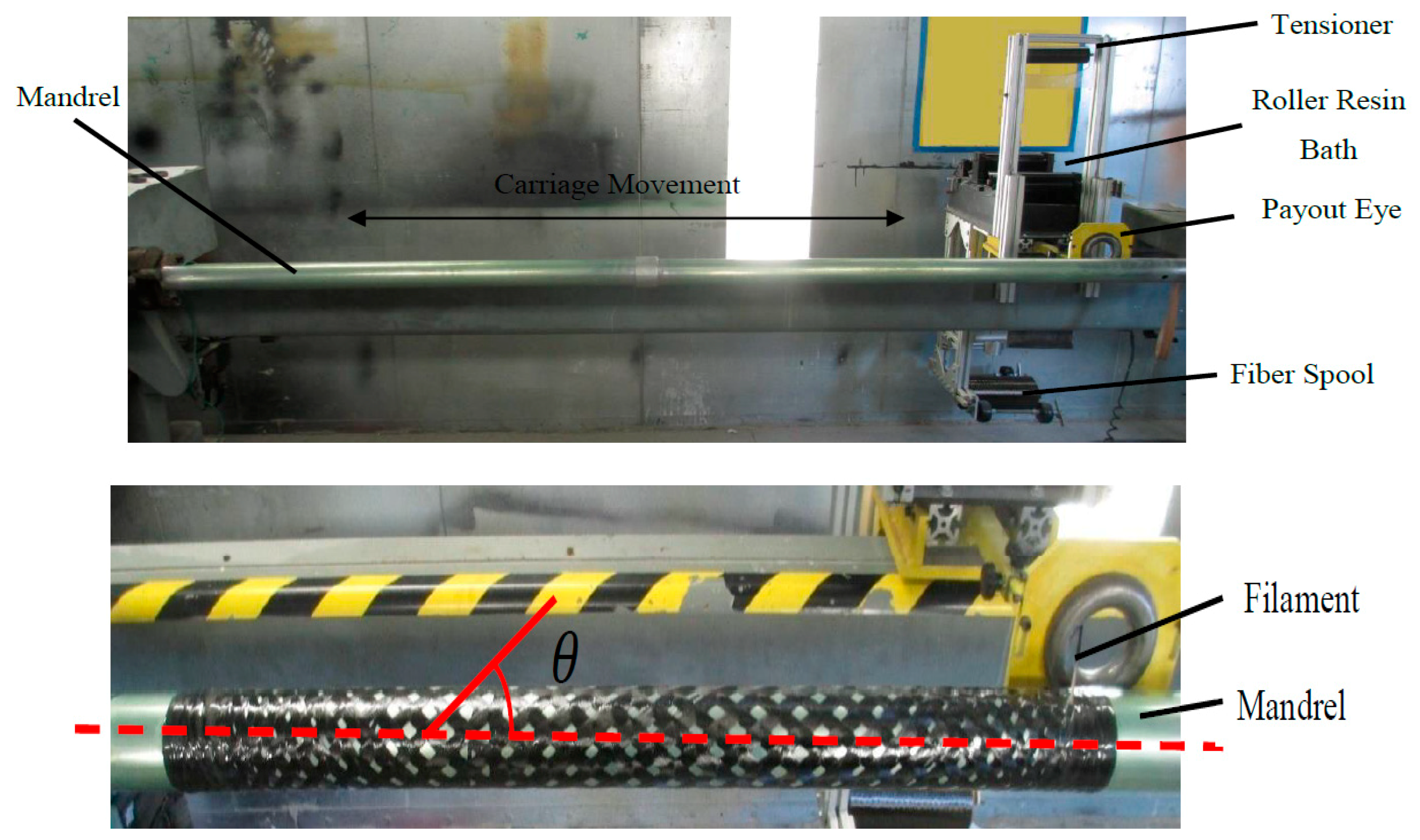
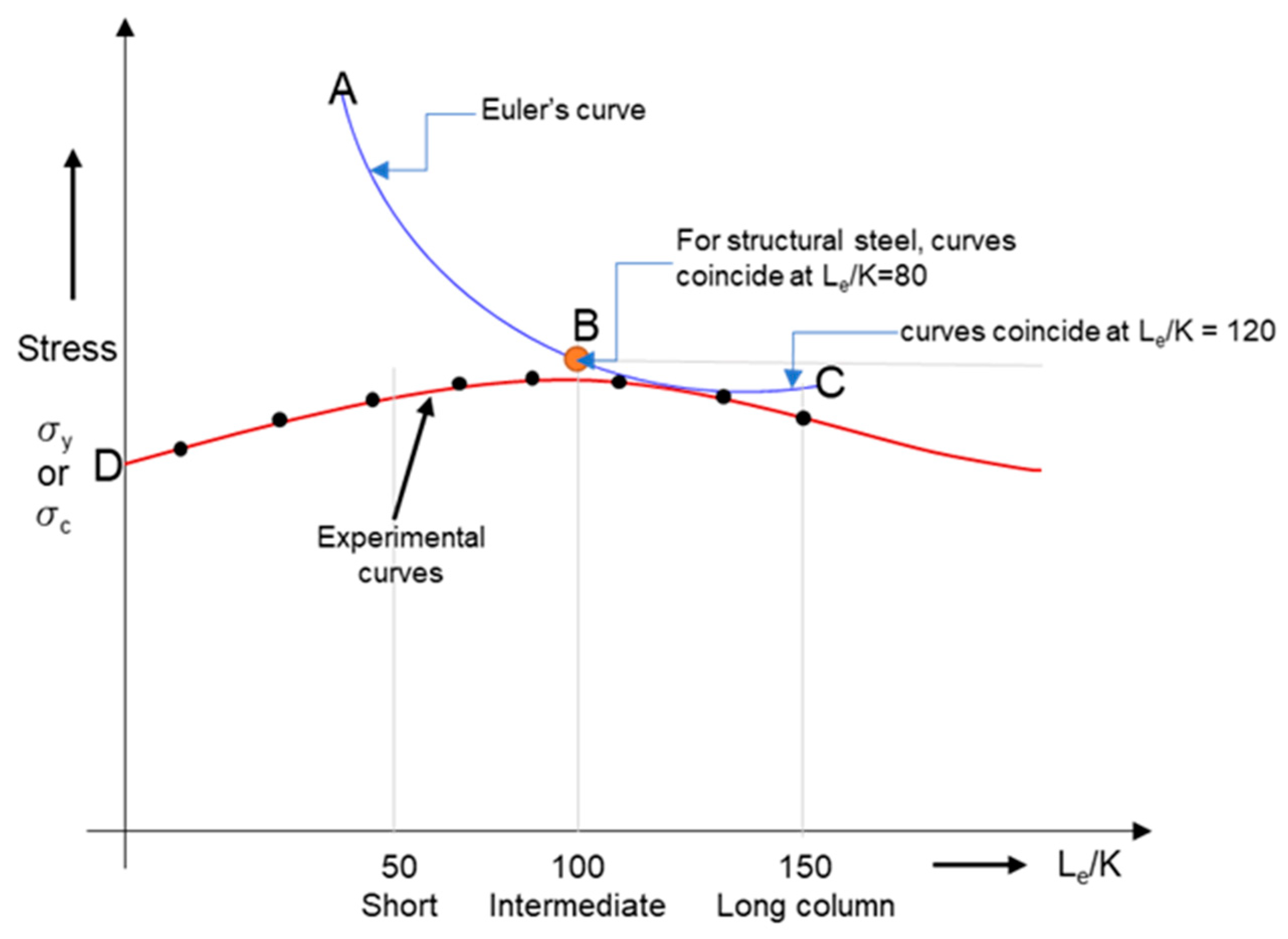
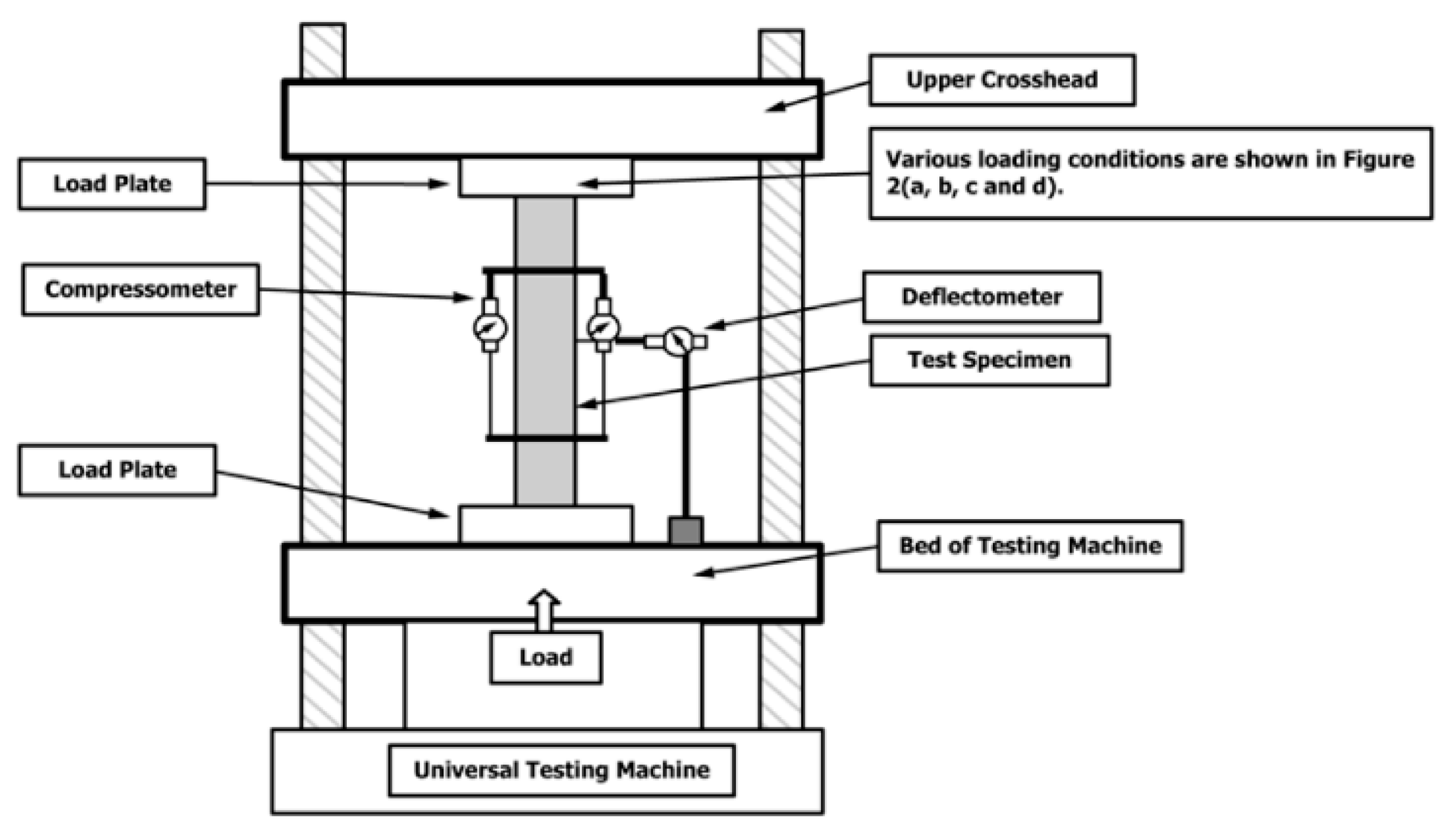


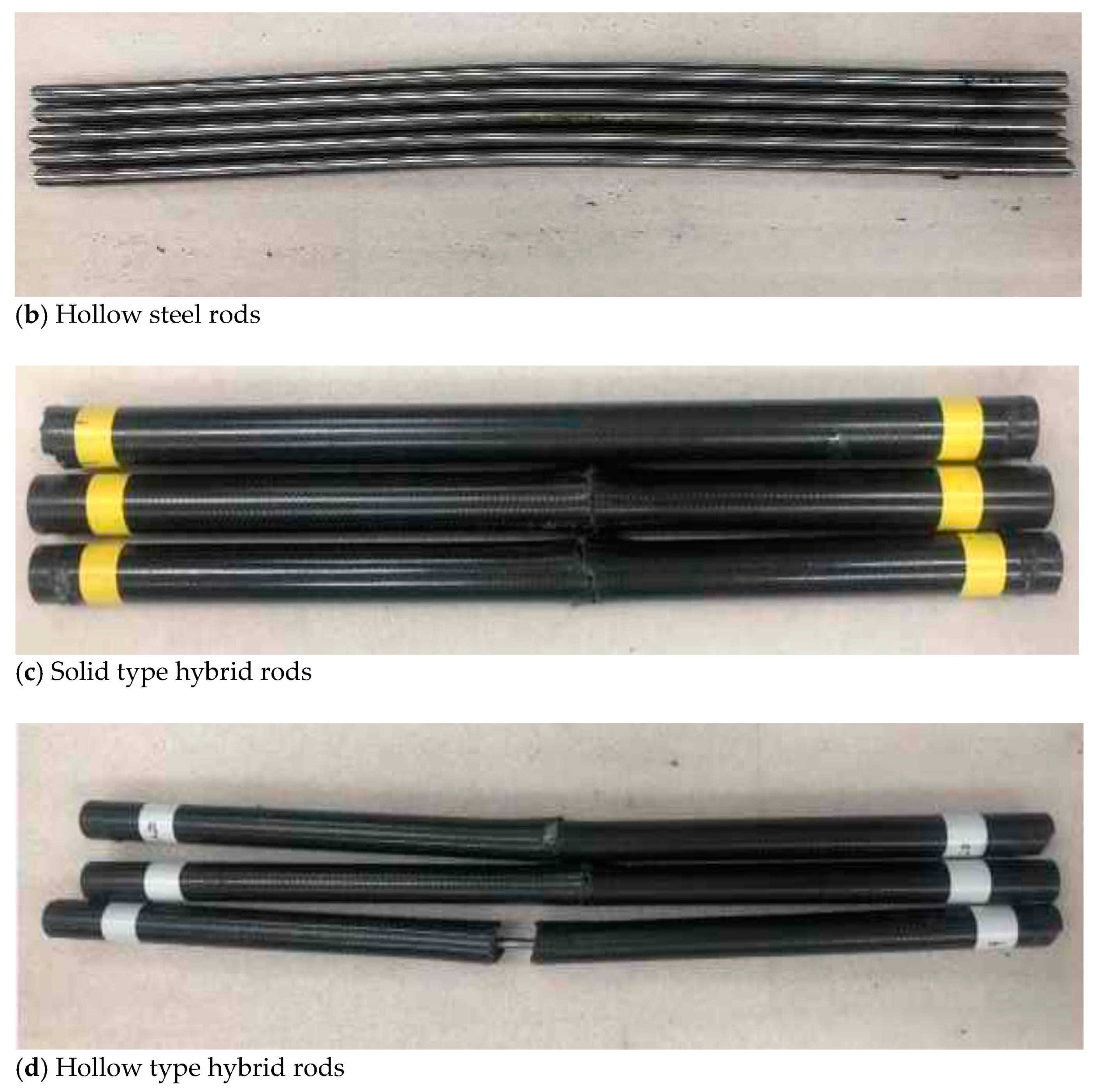
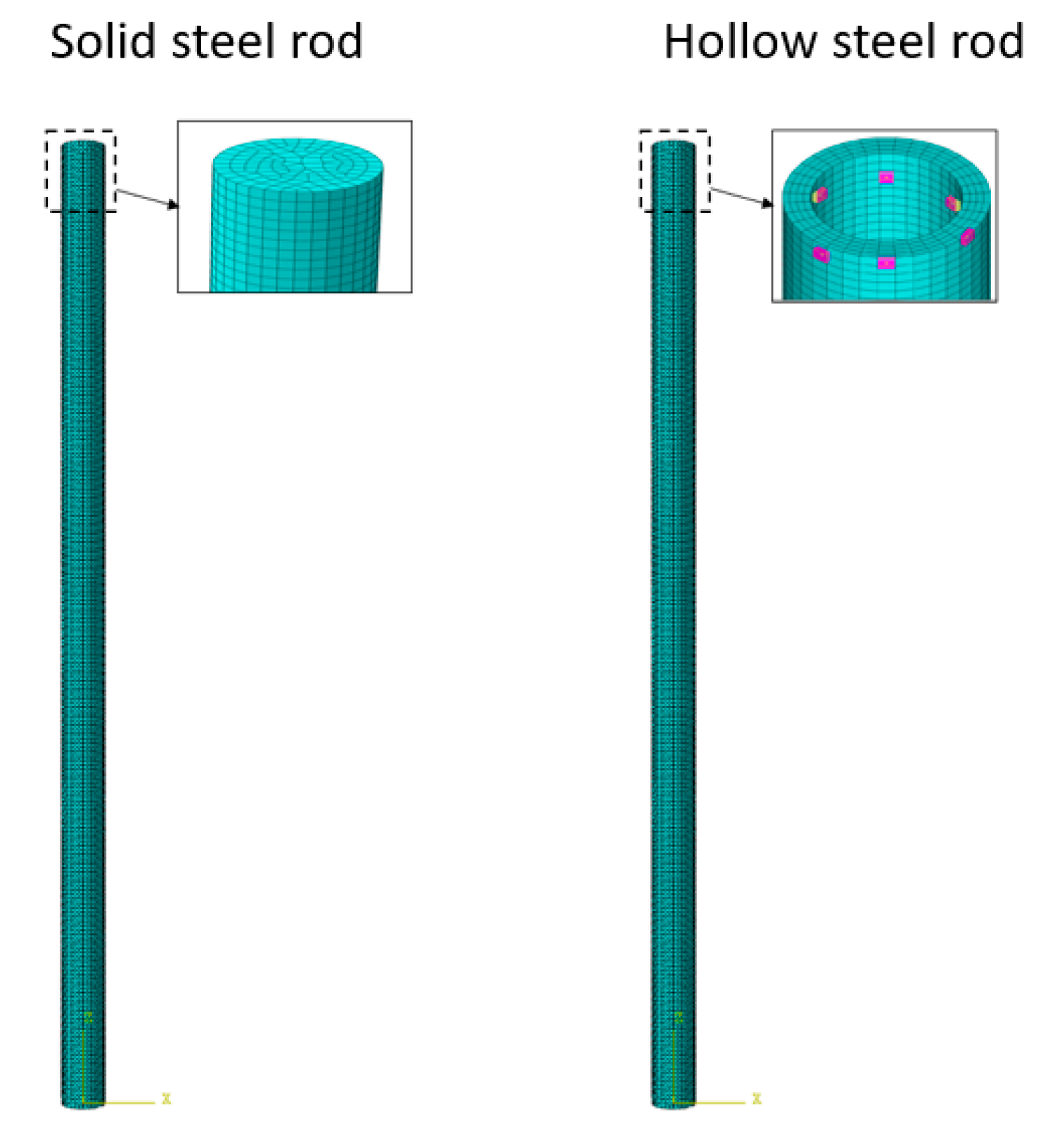

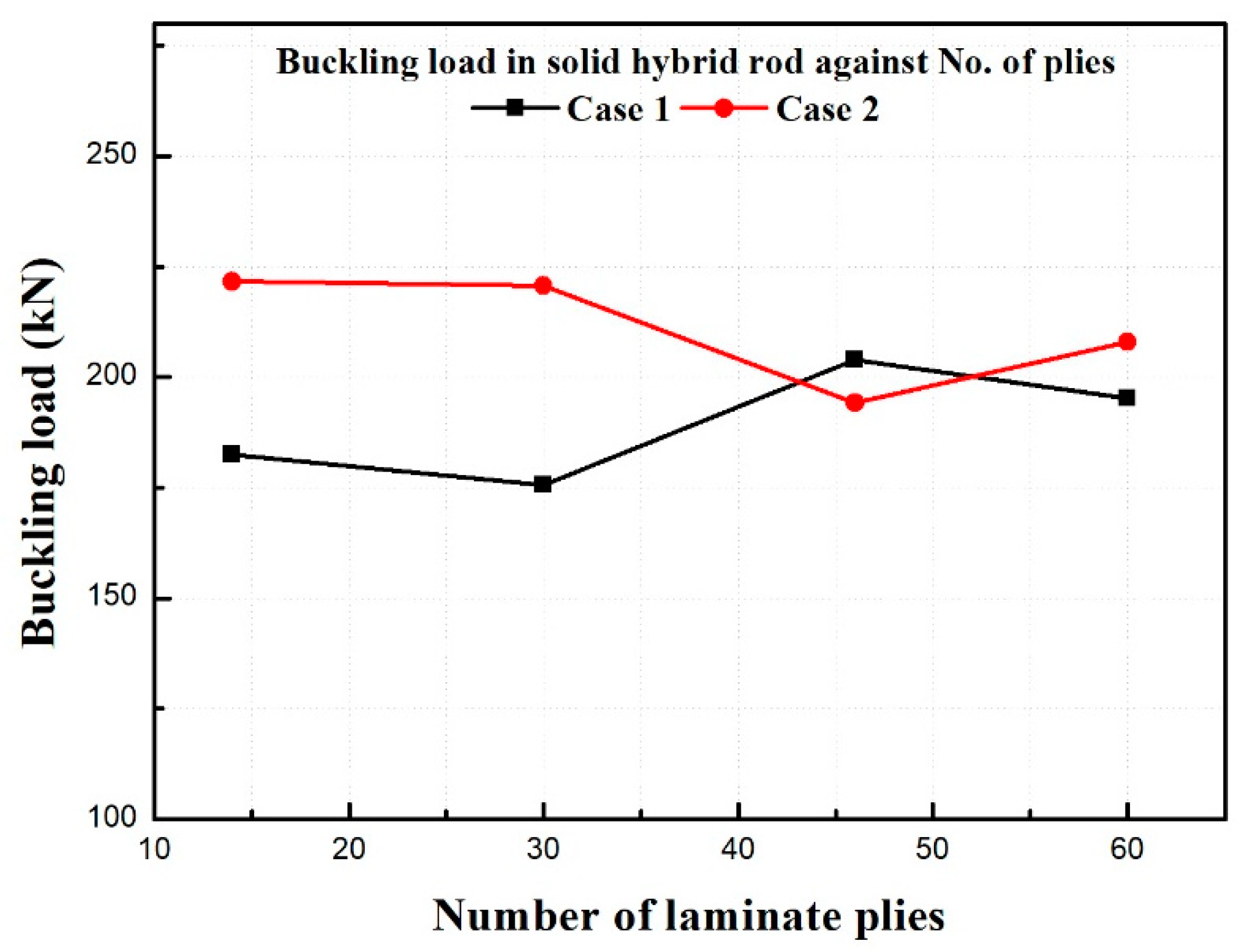
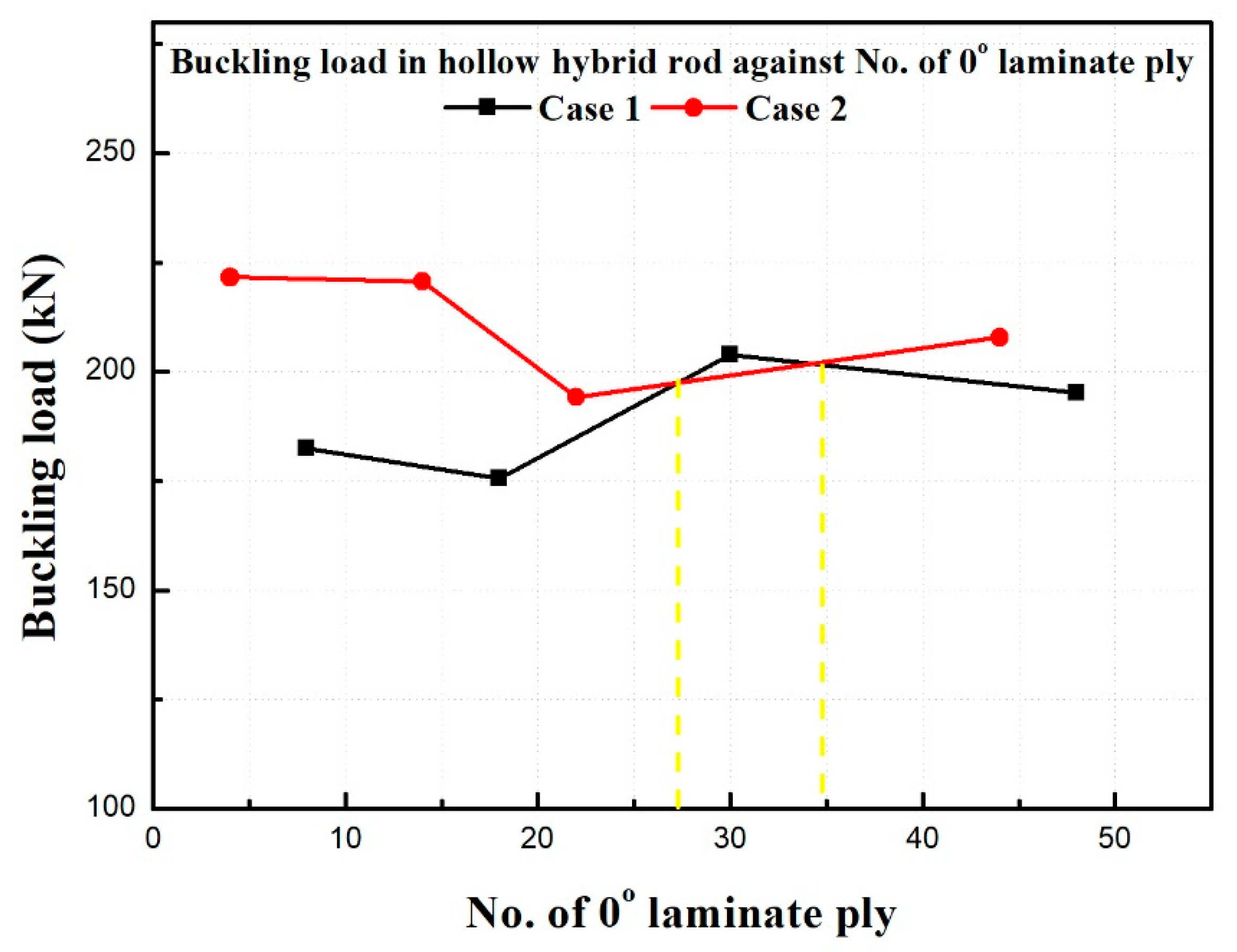

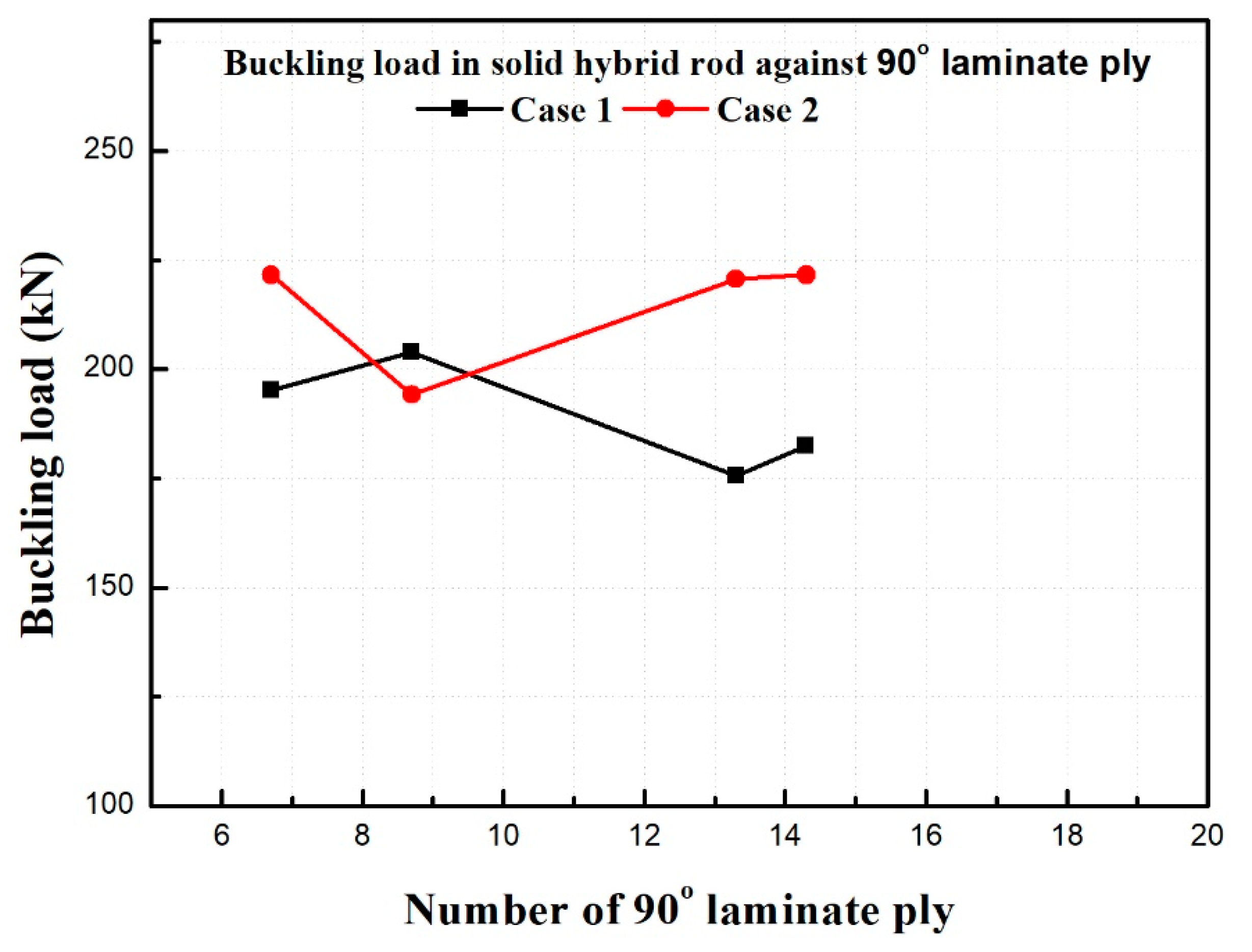

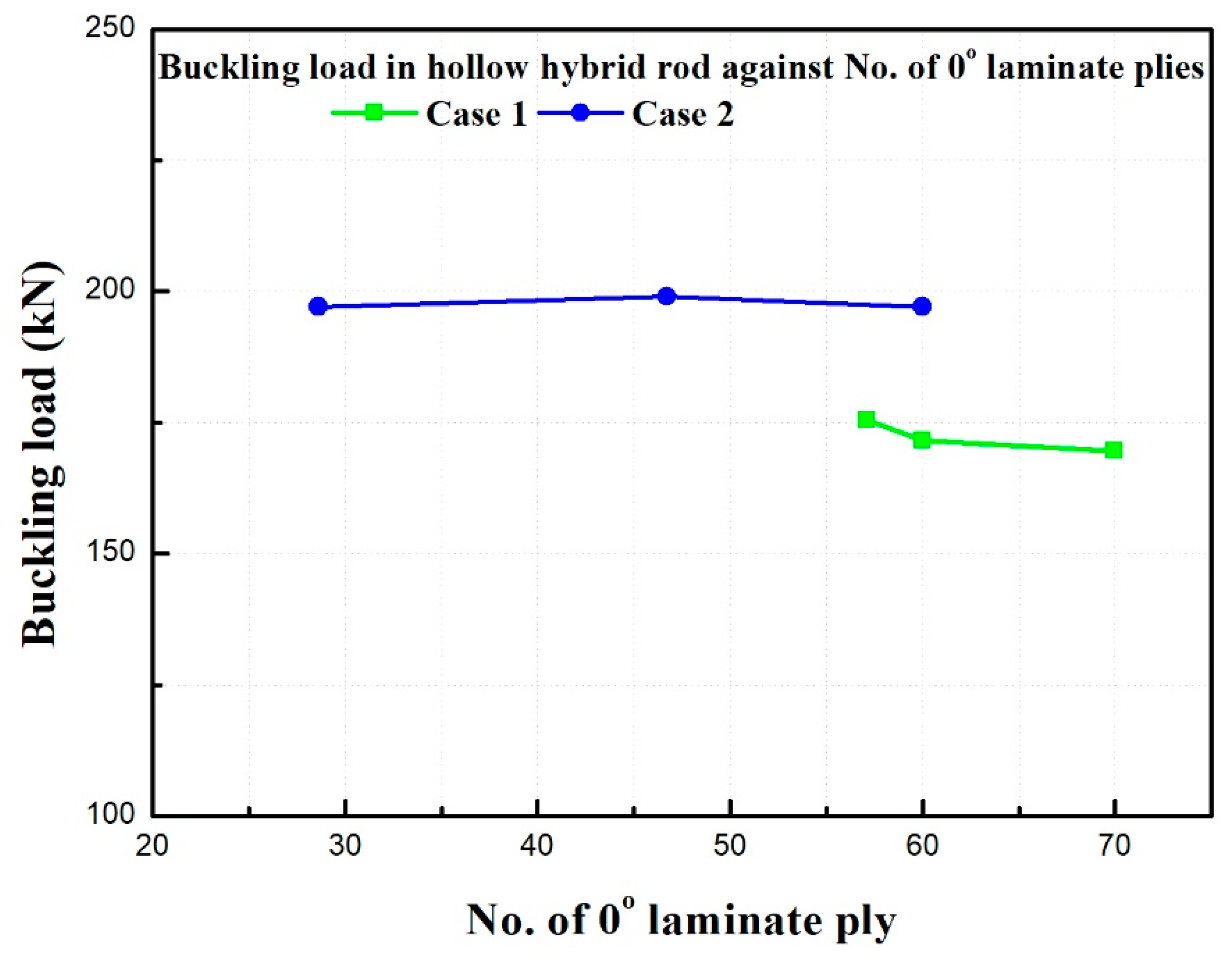
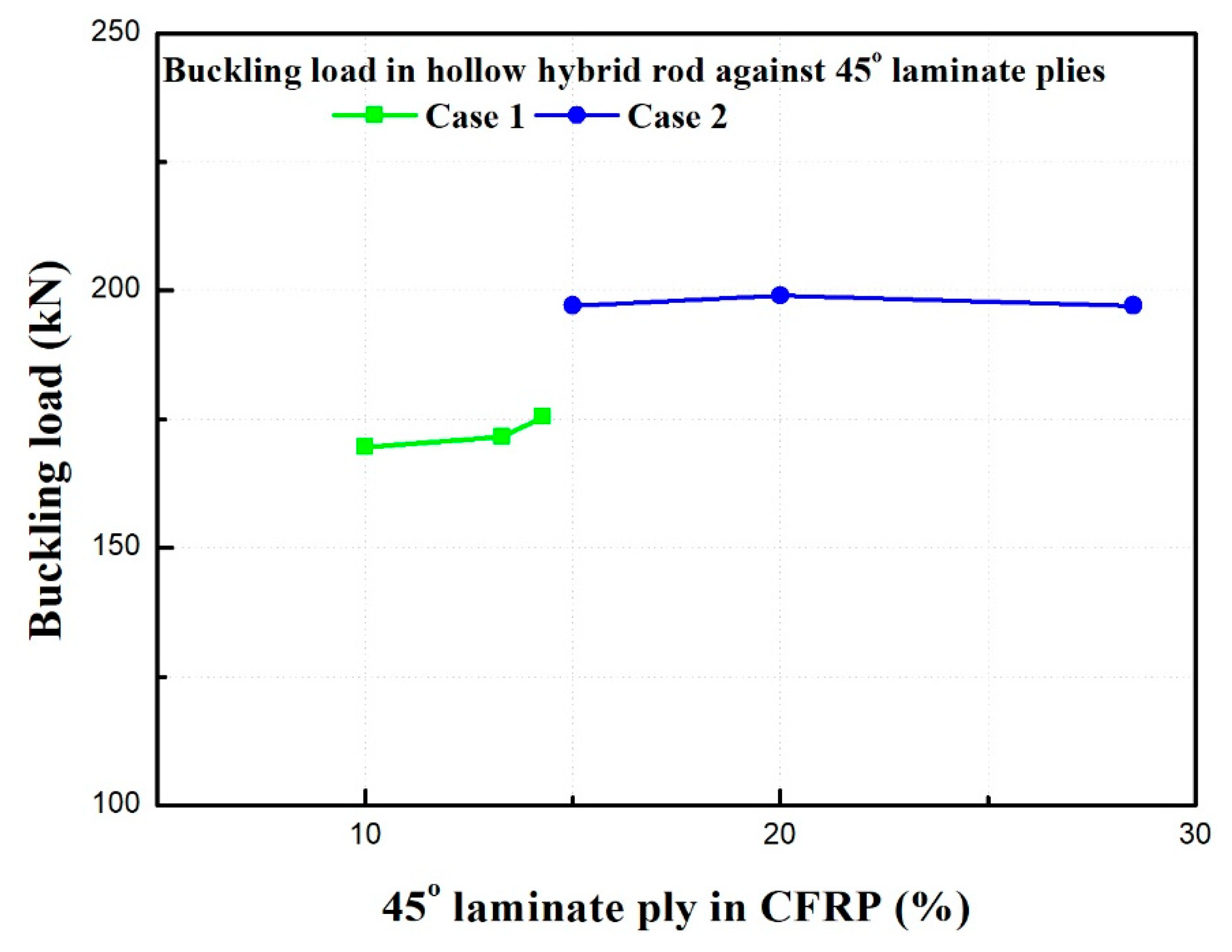

| S.No | Slenderness Ratio | Type of Column | Mode of Failure |
|---|---|---|---|
| 1 | Between 0 to 40 | Short Column | Crushing |
| 2 | Between 40 to 125 | Intermediate Column | Combined crushing & Buckling |
| 3 | Greater than 125 | Long Column | Buckling |
| Steel | Elastic Modulus Es [MPa] | Yield Strength Ys [MPa] | Poisson’s Ratio |
|---|---|---|---|
| AISI 1045 | 206,000 | 530 | 0.29 |
| Continuous Reinforcement | Tensile Modulus Ef [MPa] | Tensile Strength sf [MPa] | Density rf [g/cm3] |
| Intermediate | 300,000 | 5500 | 1.80 |
| Modulus (IM) | |||
| Carbon Fiber | |||
| Matrix | Tensile Modulus Em [MPa] | Tensile Strength sm [MPa] | Density rm [g/cm3] |
| Epoxy | 3800 | 100 | 1.22 |
| Steel Rod Type | Outer Diameter (mm) | Inner Diameter (mm) | Length (mm) | Young’s Modulus (N/mm2) | Slenderness Ratio (No Unit) | Buckling Load (kN) | ||
|---|---|---|---|---|---|---|---|---|
| Theoretical | Numerical | Experimental | ||||||
| Solid | 7.50 | - | 650.00 | 206,000 | 346.67 | 2.94 | 2.92 | 3.79 |
| 15.00 | - | 650.00 | 206,000 | 173.33 | 34.32 | 39.13 | 41.31 | |
| 22.50 | - | 650.00 | 206,000 | 115.56 | 114.74 | 121.36 | 120.72 | |
| 30.00 | - | 650.00 | 206,000 | 86.67 | 280.39 | 297.32 | 291.26 | |
| Hollow | 15.00 | 10.00 | 650.00 | 206,000 | 144.22 | 28.66 | 25.12 | 29.43 |
| 22.50 | 10.00 | 650.00 | 206,000 | 105.60 | 101.99 | 106.31 | 110.09 | |
| 30.00 | 10.00 | 650.00 | 206,000 | 82.22 | 246.09 | 231.34 | 257.92 | |
| Rod Type | Sample | CFRP Volume % | No of Laminate Plies | Laminate Orientation | Experimental Buckling Load kN | Weight in Kg | |||
|---|---|---|---|---|---|---|---|---|---|
| 0° | 45° | −45° | 90° | ||||||
| Solid steel rod | 0 | 0 | 0 | 0 | 0 | 0 | 291.26 | 3.6 | |
| Hybrid Solid | Case 1 | 25 | 14 | 8 | 2 | 2 | 2 | 182.40 | 2.30 |
| 50 | 30 | 18 | 4 | 4 | 4 | 175.54 | 1.38 | ||
| 75 | 46 | 30 | 6 | 6 | 4 | 203.98 | 0.84 | ||
| 100 | 60 | 48 | 4 | 4 | 4 | 195.15 | 0.66 | ||
| Case 2 | 25 | 14 | 4 | 4 | 4 | 2 | 221.63 | 2.32 | |
| 50 | 30 | 14 | 6 | 6 | 4 | 220.65 | 1.40 | ||
| 75 | 46 | 22 | 10 | 10 | 4 | 194.17 | 0.86 | ||
| 100 | 60 | 44 | 6 | 6 | 4 | 207.90 | 0.68 | ||
| Hollow steel rod | 0 | 0 | 0 | 0 | 0 | 0 | 257.92 | 3.18 | |
| Hybrid Hollow | Case 1 | 25 | 14 | 8 | 2 | 2 | 2 | 175.55 | 1.90 |
| 50 | 30 | 18 | 4 | 4 | 4 | 171.62 | 0.98 | ||
| 100 | 40 | 28 | 4 | 4 | 4 | 169.66 | 0.58 | ||
| Case 2 | 25 | 14 | 4 | 4 | 4 | 2 | 197.12 | 1.92 | |
| 50 | 30 | 14 | 6 | 6 | 4 | 199.08 | 1.00 | ||
| 100 | 40 | 24 | 6 | 6 | 4 | 197.12 | 0.60 | ||
Publisher’s Note: MDPI stays neutral with regard to jurisdictional claims in published maps and institutional affiliations. |
© 2021 by the authors. Licensee MDPI, Basel, Switzerland. This article is an open access article distributed under the terms and conditions of the Creative Commons Attribution (CC BY) license (https://creativecommons.org/licenses/by/4.0/).
Share and Cite
S P, P.K.; Lee, S.-S. Design and Experimental Analyses of Hybrid Piston Rods Used in Hydraulic Cylinders under Axial Load. Appl. Sci. 2021, 11, 8552. https://doi.org/10.3390/app11188552
S P PK, Lee S-S. Design and Experimental Analyses of Hybrid Piston Rods Used in Hydraulic Cylinders under Axial Load. Applied Sciences. 2021; 11(18):8552. https://doi.org/10.3390/app11188552
Chicago/Turabian StyleS P, Praveen Kumar, and Seok-Soon Lee. 2021. "Design and Experimental Analyses of Hybrid Piston Rods Used in Hydraulic Cylinders under Axial Load" Applied Sciences 11, no. 18: 8552. https://doi.org/10.3390/app11188552






